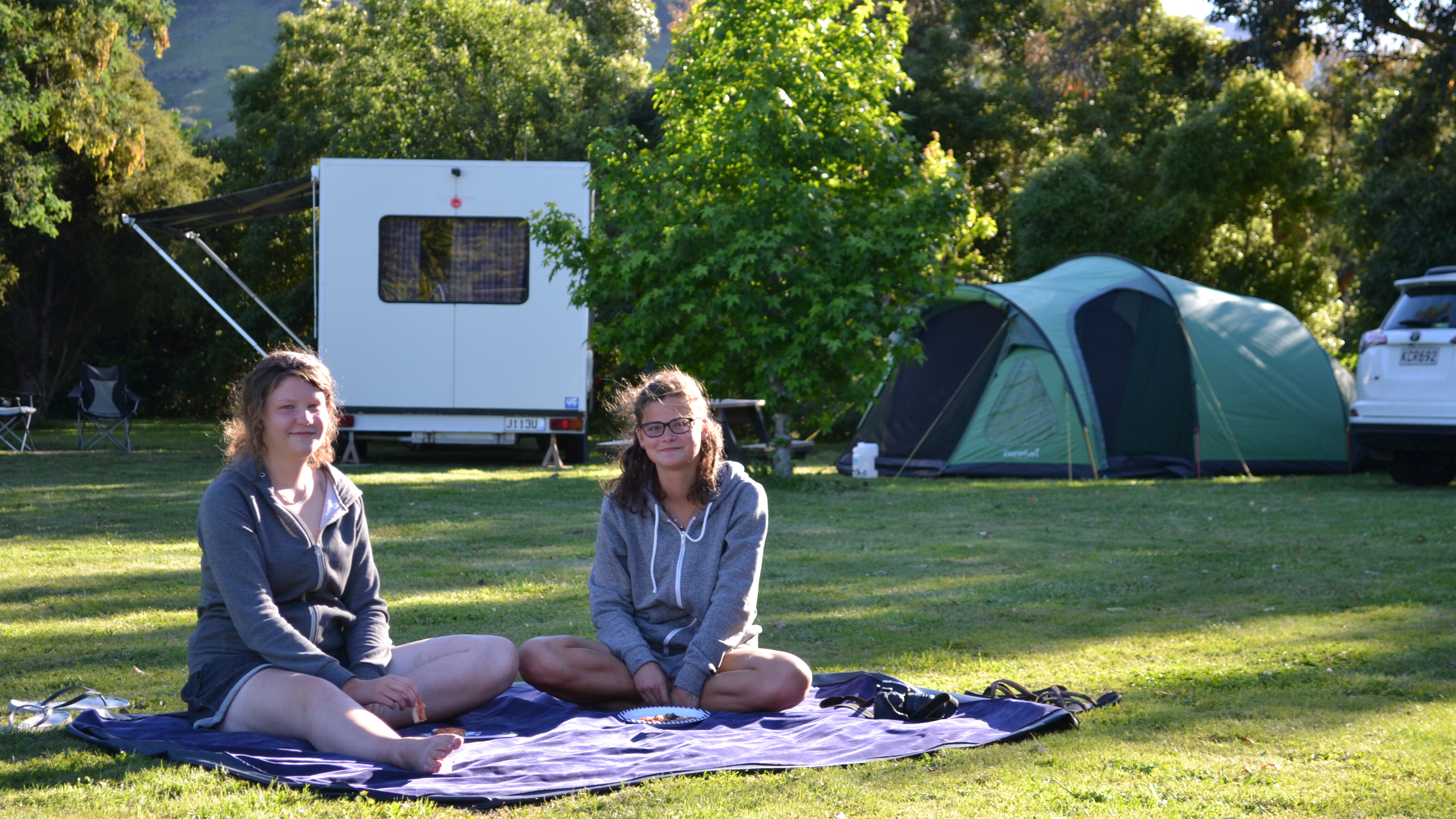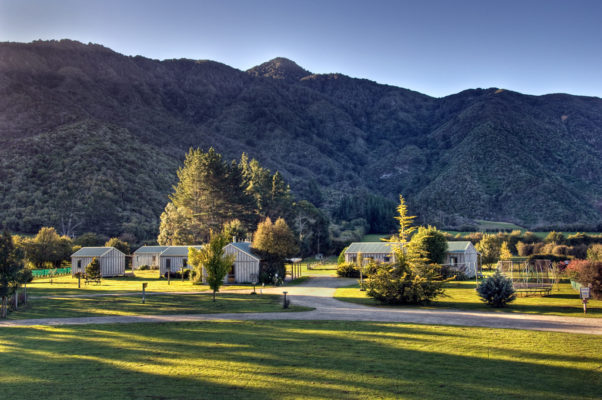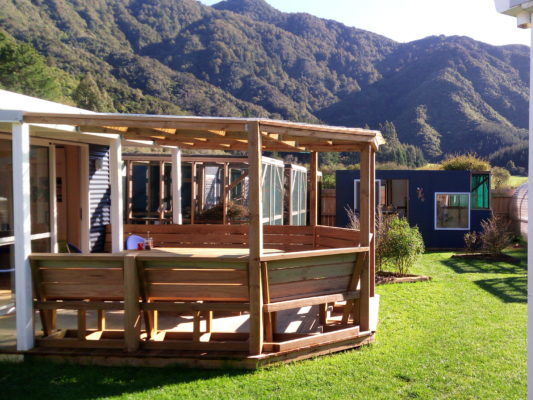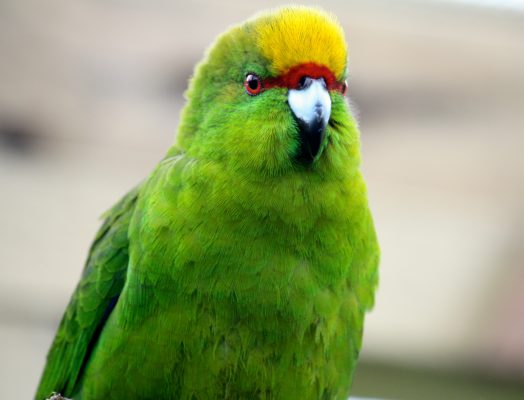Both Chris and Barbara Faulls used to have careers in the military. It meant an adventurous life with postings to all sorts of locations around the world, but in 1996 they made the decision to return to the remote beef farm in the Marlborough Sounds where Barbara had grown up.

“We got to the point in our careers where we felt that military life wasn’t conducive to family life,” says Barbara. “Chris was an army engineer and he was overseas all the time, setting up demining schools and cyclone relief aid and reconnaissance in the Islands. We wanted to bring up our children ourselves and not have to rely on friends, family or day care centres.”
So, the Faulls returned to Smiths Farm and began to develop the germ of an idea that Barbara’s father had considered many years earlier.
Smiths Farm is a 30 minute drive from Picton, located 4km from Anakiwa and close to the Queen Charlotte Track. Barbara’s father bought the property back in 1963 and over the years the family noticed the growing number of cyclists touring through the area.

“We’d wake up to find a tent had gone up overnight in the paddock,” Barbara recalls. “Some of the tourists were freaked out when they woke the next morning to find they were surrounded by cows!”
Her father thought they should create a place for people to camp, a (cow-free) copse of trees rather than an open paddock, but that was as far as the fledgling eco-tourism idea went for many years.
“When Chris was my fiancé I brought him down to visit. By then my father had died, but Chris thought Dad’s idea of a holiday park was an innovative idea for a career outside the military,” Barbara says. “We came back permanently to live here in 1996 and started building in 1997.”
As a family, the Faulls had always been interested in conservation.
“When we returned to the South Island to start our business we were adamant that our holiday park had to be built around park-like surroundings that would both blend into the environment, but also would actively attract native birds. It had to ‘sit well’,” Barbara explains.
“We have planted hundreds of trees and flowering shrubs to achieve this and now the park has literally hundreds of birds ranging from the very small grey warblers and wax eyes to the bigger pukekos, wekas, moreporks, grey herons, etc. Our mantra has been ‘what is good for conservation is good for business (and vice versa)’ and so far, it seems to have worked.”
Pest eradication has been a key part of that process.
“We have carried out several forms of pest eradication over the years with rat, stoat and possum trapping and poisoning and have also on arbor day planted native trees in an area of regenerating native bush at the back of the farm with the help of local school children,” says Barbara. “We actively lay Vespex for wasps as well as searching for paper wasp nests and destroying them. We have noticed that paper wasps are becoming as much of (if not more) a pest than their German counterparts.”
The once huge population of various types of stick insects is the most noticeable affected species and Barbara is sure that they are being attacked and preyed on by wasps.
The remote, forested location close to a popular walking track makes for an idyllic holiday park location. Smiths Farm even has its own 20 metre waterfall and 5 or 6 big areas where glow-worms can be seen.
“Guests are blown away by the glow-worm experience,” says Barbara.
Unlike bigger tourist attractions, visiting the glow-worms at Smiths Farm isn’t a controlled and orchestrated package. It’s a genuine ‘in the wild’ experience.
“Visitors use a map. There’s no guide or sealed trail. They’re out in the dark with strange noises and the occasional possum. It forces them outside of their comfort zones while at the same time being both exciting and peaceful. They are often chuffed at their achievement,” says Barbara.
Not everyone is quite sure what to expect, however.
“There was one lady who came running back in to say she’d seen the biggest-ever glow-worm! She insisted on taking me outside to show me – and it was a solar garden light! Perhaps she needed to visit Specsavers!”
Possum encounters on the glow-worm walks are a lot rarer now than they used to be, although possums have yet to be completely eradicated.
“Five years ago, we had a contractor in and in just 2 weeks he removed 650 possums from a small area on the waterfall track,” says Barbara. “The difference afterwards was incredible. The tomtits came back. We hadn’t seen them in years. They’re delightful, beautiful birds!” Predator management and eradication is ongoing, but re-invasion from surrounding areas is always going to be a challenge.
Recently Barbara’s husband Chris made another exciting bird sighting.
“When Chris was walking to our waterfall a few weekends ago he spotted a kakariki in the wild. We can only assume that it is one that has been released elsewhere in the Sounds that has found its way to our farm,” says Barbara.

Some of the plants on Smiths Farm are pretty special too.
“The farm has a QEII covenant on an area of land where there is a rare orchid,” says Barbara, “and we are aware that there is also a rare fern in the microclimate of the native bush, as Christchurch University botanists used to come and visit to look at it.”
Recently some other rare species have been settling in to a new home at Smiths Farm. The latest conservation venture at the holiday park is a joint-venture with fellow conservationists Ellen and Brian Plaisier of Tui Nature Reserve.
“We have formed a partnership with Tui Nature Reserve and they are currently setting up a facility for breeding kakariki, gecko and weta at our park,” Barbara explains. “Ellen and Brian have created the Koru Breeding Facility at the holiday park where they breed kakariki (10 babies so far!) and they also have giant weta and geckos. It will be opening officially soon so that our guests and other tours can come through and see these endangered species and learn about this conservation programme.”
Tours of the Koru Breeding Facility will be by arrangement, so that the breeding birds aren’t overwhelmed. Native plantings around the aviaries are also being carried out. The shared project not only reflects a shared interest in conservation but also has benefits for both families.
“Tui Nature Reserve is on a ‘mainland island’ in Pelorus Sound, where the only access is by boat,” Barbara explains. “The Plaisiers have tours visiting but wanted a facility closer to the public so that they can teach more people about their work. It’s a fantastic aviary and will be opening officially in the next week or so.”
Ellen and Brian Plaisier have been carrying out predator control at their award-winning Tui Nature Reserve and neighbouring property for over 20 years, resulting in the return of some native species. Other once-present species will need to be reintroduced if they are to return.
“About 10 years ago we decided to go a step further and applied for permits to breed native species for release,” says Ellen. “We’ve started with red crowned kakariki to learn to keep them and in the years following we got to look after the Stephens Island giant weta and the yellow crowned kakariki. Since then, we’ve had releases of yellow crowned kakariki at Project Janszoon located at Abel Tasman and giant weta has been released on Puangiangi Island.”
Gecko have also been bred successfully by the Plaisiers.
“About six years ago we released common gecko at Tui Nature Reserve that we’ve bred for this purpose. It is our intention that in the near future we can also start releasing other species at Tui Nature Reserve and neighbouring property, Sealife Trust,” says Ellen.

“We currently hold Stephen’s Island giant weta and yellow crowned kakariki. We also hold Marlborough green gecko, however these are for viewing only. We have about a dozen Kakariki although that number changes while the breeding season is well on its way. As for the weta, this number changes too. Some of the older weta will die after laying eggs but the young ones (nymphs) will hatch from November, December onwards. There would be at least around the hundred.”
The Plaisiers are also planning to add to their wildlife breeding menagerie in the future.
“We are keen to get different weta species and we also like to breed reptiles for release. We would also be keen to breed the rare orange crowned kakariki and the giant snail,” says Ellen. “We also work with other facilities and exchange birds to keep healthy genes.”
It’s a full-on commitment for the Plaisiers, who have recently extended their breeding facilities with the new buildings at Smiths Farm. Both projects (Tui Nature Reserve and Koru Native Wildlife Centre) are run by a registered charitable organisation called Tui Nature Reserve Wildlife Trust.
“Rodents are the biggest issue when it comes to vulnerable species. So, we’ve built facilities that are rodent proof, they are wrapped around with X-cluder netting. We are also working on a nocturnal building for the weta. Its all pretty expensive but thanks to our sponsor New Zealand King Salmon Ltd, the Lottery Foundation and Rata Foundation, we’ve made it work.”
Ellen and Brian are hoping that the new location will help them share their work with more people.
“This location was chosen because of the accessibility for the public as Tui Nature Reserve has only boat access. We also like to use the wildlife centre for awareness and education purposes and an added advantage is that there is someone on the park 24/7 which is good for the security of the animals.” Ellen explains. “The link to the Faulls family was an easy one because of the very friendly and professional atmosphere at the holiday park and we can also use the facilities at the campground for our visitors.”
“While breeding the species is our main focus we do feel there is also a need for advocacy. Usually we offer two tours per day where we show visitors around and tell them why we ended up here doing what we are doing today.”
Visiting is by appointment only and can be made though the website www.koruwildlife.nz .
“Visiting is controlled with low numbers of visitors as we don’t want to cause too much disruption to our breeding wildlife.”
Barbara has loved weta since she was a child, so breeding giant weta in the Koru aviaries is also exciting.
“There was an old haybaling implement embedded in a creek when I was growing up,” she recalls. “There was a little toolbox next to the seat and weta were breeding in there. There are also cave weta in the area of Smiths Farm,” she adds.
Barbara is keen to get to the next generation of children growing up in the area as interested in conservation as she was.
“Locally, we hope to encourage the Linkwater School children to take part in a possum trapping project where the possums are then given to a local trapper so that he can strip the fur. This is a work in progress,” she says.
She’s also planning a Christmas Challenge for three of the staffs’ children at Smiths Farm over the summer school break.
“It will be a bit like a ‘Dragon’s Den’ challenge to come up with a trapping plan for the park. I want the children to identify areas where there are pests and say what they think we should do, so they take ownership and pride in the park and they can earn some pocket money too. I’m committed to getting possums, stoats and rats under control,” she says. “One of the girls already traps possums with her Dad and sells the fur.”
With Ellen and Brian Plaisier already trapping around the Koru Breeding Facility, it’s ‘all hands on deck’ at Smiths Farm, to ensure that wild birds in the area, as well as kakariki in the aviaries, have a safe and fruitful place to breed and thrive. Perhaps more wild kakariki will be spotted too, as the aviary birds make their usual parakeet racket and call other birds in. All in all, life for Barbara and Chris and their family these days couldn’t be more different than their former military careers.

